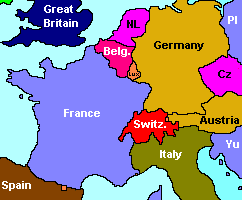
Economic Dependance

|
Second World War Economic Dependance |
Switzerland's Economic Dependence
|
 |
As Switzerland never had colonies nor direct access to the sea, and as it shares its three major languages with the neighbours Germany, Austria, France and Italy, these have always been the most important partners of trade and financial relations. During World War II Switzerland was completely surrounded by Germany (including Austria from 1938 to 1945), Germany's ally Italy and by France (partly occupied by German troops from Summer 1940, partly controlled by the Vichy-based regime collaborating with Germany after the French surrender in 1940). |
Any Swiss import or export to other trade partners was under German control!
Switzerland had to choose between keeping up it's trade and financial
relations with it's neighbours on a normal pre-war level OR complete
surrender and collaboration. There was absolutely no chance for a third way.
Switzerland, unlike Austria, chose as much independence as possible
for a small country under the conditions dictated by the great powers.
During the war food was scarce, the authorities aimed at a fair distribution with rationing. Each person was allowed to buy only a certain quantity of food and goods of daily use per month, monthly rationing stamps were delivered to control this. However one may doubt, whether all regulations were just in detail - a complete lunch in the restaurant was delivered for example against two bread stamps, a kilogram (two pounds) of bread against ten stamps. Many farmers were not very disciplined, too.Food was often given from the farms directly to relatives and good acquaintance circumventing the rationing system.
Very many articles of daily use were rationed:Note that alpine agriculture is specialized in producing milk, cheese and meat, since grass is about the only thing that can be grown in the higher alpine regions. Meat was not affordable as everyday product for the lower classes, however. This explains, why meat was rationed only relatively late in 1942. On the other hand, some basic products like rice can't be cultivated in Switzerland at all, while wheat, corn, fat and oil must be imported to a high proportion. This explains, why these products were among the first to be rationed.
The bread ration amounted to only 225 g (8 ounces)/day (from October 1942 - February 1944), to 250 g (8.8 ounces)/day (after 1 March 1944, however under admixture of potato flour). Bakers had to store bread 24 hours after baking, later even 48 hours - thus the appetite should be throttled in natural way. Potato bread went sour not too long after this period. The slogan: "old bread is not hard - no bread is hard" is still remebered by elder persons.
Also many products of rubber were not any longer available. Bicycle tires were made e.g. of cork. On tractors special devices were added to produce gas by burning wood, which served as fuel replacement for the diesel engine. Gasoline for cars was only available if a absolutely necessary, as for medical service. . The rationing could be waived completely only on July, 1st1948, thus more than three years after end of war.
Already in April 1939 the Swiss parliament approved a resolution for the increase of agricultural production. Friedrich Traugott Wahlen planned the so-called "cultivation battle" as a chief civil servant in the Swiss Federal Office for War Nourishing. Every green area that seemed to be usable was cultivated according to the " Wahlen Plan" with bread grain, vegetables or potatoes. The cultivated area almost tripled till the end of war, the self-sufficiency degree rose from 52 % in 1939 to 59 % (compared to pre-war consumption), which meant 80 % considering the scarcer rations during war . Still, 20 % of food had to be imported. Raw materials like metals, rubber, coal and all sorts of fuel etc. had to be imported almost completely because there are no significant deposits in Switzerland.
|
Disclaimer
|
GESCHICHTE-SCHWEIZ.CH
© Copyright 2004 All Rights Reserved
|
Imprint
|
|